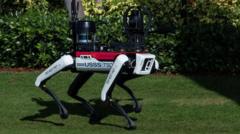
The US Secret Service has deployed a robotic dog named “Spot,” manufactured by Boston Dynamics, to patrol the perimeter of President-elect Donald Trump’s Mar-a-Lago resort in Palm Beach, Florida. This high-tech security tool has garnered significant attention on social media platforms like TikTok, with reactions ranging from fascination to unease.
The deployment of Spot comes in the wake of two apparent assassination attempts against Trump in recent months – one at a Pennsylvania rally and another at the Mar-a-Lago golf course. While both the Secret Service and Boston Dynamics have been tight-lipped about specific details, the agency emphasizes that safeguarding the president-elect is a top priority.
Ron Williams, a former Secret Service agent, suggests that the recent security incidents have accelerated the agency’s efforts to upgrade technological surveillance capabilities. The robotic dog offers several advantages in security operations. Spot can navigate complex terrains, including stairs and tight spaces, and is equipped with advanced surveillance technology.
The device features multiple cameras that generate 3D maps of its surroundings and can be fitted with additional sensors like thermal imaging. It can be controlled remotely by a human operator using a joystick or programmed to follow predefined routes. Unlike human or real canine security personnel, Spot remains undistractable by visual, auditory, or olfactory stimuli.
Each robotic dog is marked with a “DO NOT PET” warning, though experts like Melissa Michelson note that their appearance is far from cuddly. The devices are not weaponized, though there are indications that some international competitors are exploring armed versions.
Despite their technological sophistication, these robotic dogs are not intended to replace human security personnel entirely. They are viewed more as an assistive technology, similar to advanced driver-assistance systems in modern vehicles. Secret Service agents continue to patrol alongside Spot, ready to intervene if technological systems fail.
The robots are not without vulnerabilities. Professor Missy Cummings notes that simple interventions like spraying hairspray on the device’s sensors could potentially disable its camera systems.
The use of robotic dogs is not unique to the Secret Service. Williams points out that militaries and law enforcement agencies worldwide are increasingly adopting such technologies. Each robotic dog can cost up to $75,000, reflecting the advanced technology involved.
While the deployment of Spot at Mar-a-Lago has sparked public curiosity and media attention, the underlying message remains clear: enhancing security through technological innovation is a critical priority for protecting high-profile individuals.
As robotic technology continues to evolve, these mechanical guardians are likely to become more prevalent in security and surveillance operations, representing a new frontier in protective strategies.








